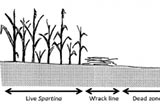Conservation research: Recovery of salt marshes after the BP oil spill
by Evan Byrnes, RJD intern
Oil spill damage has been a hot area of interest, especially since the BP Deepwater Horizon Spill in 2010. This is because oil spills can affect flora and fauna for generations, especially in coastal wetlands where decomposition is slow due to the low energy and anoxic environment. Coastal wetlands are very important habitats. They are commonly used for reproduction by various organisms, provide protection from shoreline erosion, regulate gasses and nutrients, support fishery and ecotourism industries, and much more.
Coastal wetlands are a predominant habitat in the Gulf of Mexico, yet over 3000 production platforms are active in the Gulf. This brings about major concern for potential damage to these crucial habitats. Therefore many laboratory studies have been completed studying the damage done by oil spills. However, laboratory studies have not proved pertinent because they cannot duplicate the effect of natural wave and tidal action and normally have short durations. For these reasons, McCall and Pennings took it upon themselves to conduct a field study following the BP Deepwater Horizon Spill studying the effect with natural conditions and over a longer period of time.
Their research focused on the terrestrial arthropod communities found in Spartina alterniflora stands, the most abundant plant in salt marshes along the Gulf coast. They chose to study the arthropods because they are a link between terrestrial and marine invertebrates, they have been well studied, and they occupy the lowest elevations in salt marshes, therefore associated with the most affected species.
Based on where oil landed, they used 100m transects to sample various sites. Many areas were found to have a heavily oiled, dead five meter band along the edge of the water; so the areas above this zone were sampled. Some of the different parameters measured were percent cover of live and dead plat material, nitrogen content of dried leaves, and the arthropod abundance.
It was found that soil and vegetation characteristics were similar between oiled and control sites, but the invertebrate community was fairly affected. The snails, which live on the plants, appeared to have unaltered numbers, while the crabs, which burrow in the sediment, had depleted numbers. One year later the arthropod communities made a strong recovery, possibly due to re-colonization from unaffected areas.
From their data, McCall and Pennings found that it cannot be assumed that there is no impact to a salt marsh from oil, based on the observation that the vegetation appears unaffected. Salt marsh, terrestrial arthropods were shown to be more sensitive to oil disturbances, and although showed the ability to recover relatively quickly, might not do so well if disturbances occur more than episodically. Crabs provide the important service of aerating the soil, and without them or other fauna yet to be researched, a salt marsh will potentially collapse. Hence, it is clear that the extent of oil disturbances must be more thoroughly research, and better precautionary measures must be taken to prevent them.
McCall BD, & Pennings SC (2012). Disturbance and recovery of salt marsh arthropod communities following BP Deepwater Horizon oil spill. PloS one, 7 (3) PMID: 22412916





Leave a Reply
Want to join the discussion?Feel free to contribute!